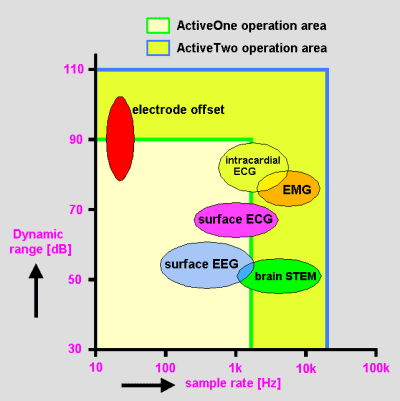| |
| What
are the advantages of a 24 bit system ? |
| |
| The
discussion about the the best choice of analog-digital converter
for an biopotential measurement system is often confused by the
habit of expressing the dynamic range in bits. The most important
specification of an ADC is the dynamic range (the ration between
maximal input signal and intrinsic noise level), which can be
expressed in dB, or in effective bits (with each bit representing
6 dB dynamic range). ADCs are categorized by the number of bits
of the generated digital output. However, the number of effective
bits is always smaller than the length of the output.
Of
the many types of ADCs available, two types have become most popular
for applications in biopotential measurement applications: the
Successive Approximation Register type ADC (SAR), and the Sigma-Delta
(DS)
type
converter. In general, the SAR type offers high speed and low
power consumption, while the Sigma Delta type offers high dynamic
range and good linearity, and no missing codes. All these features
play a role in a biopotential measurement system, so the choice
for the best type is often a complicated tradeoff. Modern SAR
types often have a noise level close to the theoretical minimum
of the quantization noise generated by the LSB value (RMS magnitude
of the quantization noise is LSB/Ö12)
. For example, the 16- bit converters used in our ActiveOne system
had a dynamic range of nearly 90 dB (15 effective bits). With
sigma delta types, each output word is calculated as an result
of many coarse 1 bit conversions (hence the name: oversampling
ADC), and the noise level is often much high than the quantization
noise. For example, the 24-bit converters used in our new ActiveTwo
system have a dynamic range of 115 dB (approx. 19 effective bits).
So the 5 least significant bits can be regarded as noise. |
| |
| |
To
answer the question which ADC would be the best choice for
an biopotential measurement system, it is instructive to reason
in terms of optimal dynamic range of the converter. The plot
at the left gives an impression of the signal amplitudes that
can be expected. Using an ADC with a high dynamic range (many
effective bits), and with a high sample rate, is attractive
because it makes the system applicable for a broad range of
biopotential measurements. However, increasing the number
of bits and sample range quickly increases the power consumption,
which we want to keep minimal to allow battery
power supply. |
|
|
| |
| Basically,
there are two routes to go: |
| AC-Amp:
|
Suppress
the large offset potential with a reduced gain at low frequencies
(by using one or more high pass stages in the amplifier).
This leaves only the AC biopotential signal to be handled
by the ADC. A 12 bit (EEG) to 14 bit (ECG) ADC is sufficient. |
| DC-Amp: |
Use
an ADC with enough dynamic range to handle the offset potentials
without any high-pass filtering |
| |
|
|
| AC-coupled
amplifier, is attractive because it uses the dynamic range of the
ADC most effectively. Until approx. 10 years ago, this was the only
option because ADCs that combined a dynamic range of more than approx.
80 dB and sufficient sample rate for biopotential measurements simply
did not exist. The main disadvantages of the AC coupled setup are
the delayed response after amplifier saturation (especially when
high gain and long time constants are used), the loss of low frequencies
from the signal (information about electrode drift is lost), and
the differences in low frequency response between the channels caused
by tolerances of the coupling capacitors. These disadvantages made
designers wishing for ADCs suitable to use a DC coupled amplifier
with an ADC with sufficient dynamic range to capture the entire
input signal (inclusive electrode offset voltages) without clipping. |
| |
| In
1995, Analog Devices introduced a 22-bit converter optimized for
biopotential measurement systems, the AD7716. This AD converter
has a dynamic range of 100dB at 1kHz. Several competitors decided
that the time of the DC coupled amplifier had arrived. The 22-bit
systems currently marketed by BioSemi's competitors are based on
this ADC, and they all
suffer from the same limitations: limited sample rate, limited input
range and high power consumption. So, untill 2001 BioSemi decided
to keep using 16-bit alternatives, and used a combination of an
AC coupled and a DC coupled amplier for the successful ActiveOne
system. This system could be used in AC mode with large +/-330 mV
electrode offset range, or in DC mode with a 66 mVpp input range. |
| |
| The
semiconductor industry has made major advances during the last years,
and the recent introduction of fast low-power 24 bit Sigma-Delta
ADC's with a dynamic range of more than 115 dB (more than 19 bit
effective resolution) allows a new step forward in the design of
biopotential measurement systems. BioSemi is proud to introduce
the new ActiveTwo, the first system
able to combine the best of both worlds. The ActiveTwo has all the
advantages of the DC amplifier: measurement of all low-frequency
information, no delay after saturation, and perfectly equal frequency
response of all the channels (no high-pass, all low-pass filtering
is digital). At the same time, the ActiveTwo is the first DC system
which retains the advantages you have learned to appreciate in good
AC designs of the past: tolerance for large electrode offset voltages
(up to +/- 262 mV), options for high sample rates (up to 16 kHz
per channel) and minimal power consumption (<10 mW per channel). |
| |
|






